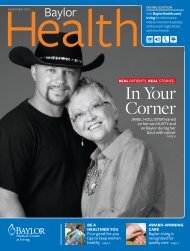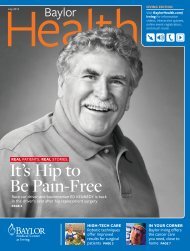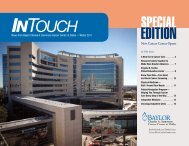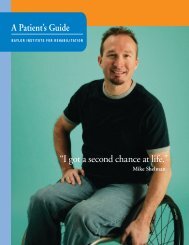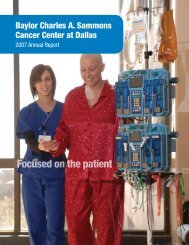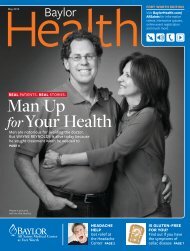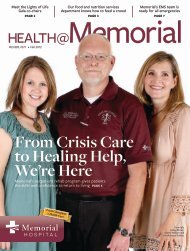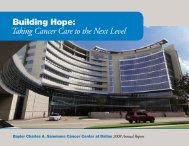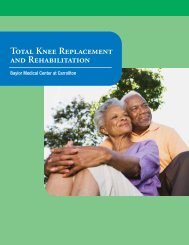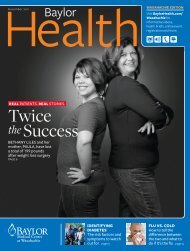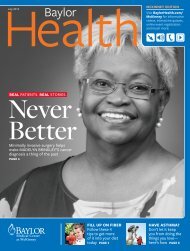Garland - Baylor Online Newsroom - Baylor Health Care System
Garland - Baylor Online Newsroom - Baylor Health Care System
Garland - Baylor Online Newsroom - Baylor Health Care System
- No tags were found...
Create successful ePaper yourself
Turn your PDF publications into a flip-book with our unique Google optimized e-Paper software.
<strong>Health</strong>May 2013<strong>Baylor</strong>GARLAND EDITIONVisit <strong>Baylor</strong><strong>Health</strong>.com/<strong>Garland</strong> for informativevideos, interactive quizzes,online event registration,and much more.REAL PATIENTS. REAL STORIES.At EaseJENNIFER SHEPPARD finallyhas the answer to unexplainedsymptoms: Crohn’s diseasePAGE 6CHECK IT OFFYOUR LISTMen, find out ifyou’re up-to-date onscreenings PAGE 2SUN SAFETYAre you doing all youcan to protect yourskin? Take our quizto find out PAGE 5
<strong>Baylor</strong>_MakesUs All Better<strong>Baylor</strong> Foundation hasset a goal of raising$250 mil lion by 2015 tostrengthen every aspectof <strong>Baylor</strong>. It marks ourmost ambitious fundraisingeffort to date. VisitGive.<strong>Baylor</strong><strong>Health</strong>.comfor more information.HomeSweetMedicalHomeHome is where peopleknow you and yourhistory. The same is truein a patient-centeredmedical home. In thisteam-based model of care,a primary physician acts as a“home base” for providing and coordinatingall of a patient’s health care needs.The National Committee for QualityAssurance, which evaluates the effectivenessof clinics following the patient-centeredmedical home model, has awarded <strong>Baylor</strong><strong>Health</strong> <strong>Care</strong> <strong>System</strong>’s <strong>Health</strong>Texas ProviderNetwork the highest possible level ofrecognition for every one of its 60 clinicsthat submitted applications. That’s thesecond-highest total number of recognitionsof any medical group in the country.With an emphasis on prevention andsuccessfully managing chronic diseases,the patient-centered medical home matchespatients with a primary care physician whoknows every doctor they see, every test orprocedure they receive and every medicationthey take.Snore AlertSnoring may be more than a nuisance. It maysignal an increased risk of cardiovasculardisease. That’s because some snorers havesleep apnea, in which they briefly stopbreathing while they sleep. And untreatedsleep apnea increases risk for heart attack,stroke and heart failure.But even garden-variety snoring may bea sign of trouble. A recent study found thatWHEN THE PROSTATECAUSES PROBLEMSDid you know that a man’s prostategland continues to grow throughoutadulthood? But if it gets too big, orenlarged, it can cause symptoms.More than half of men in their 60s,and as many as 90 percent in their70s and 80s, have some signs of anenlarged prostate, also called BPHfor benign prostatic hyperplasia orGet SleepSupportTo learn how we canhelp keep your hearthealthy by providing abetter night’s sleep, visit<strong>Baylor</strong><strong>Health</strong>.com/Sleep today.snorers were more likely to have thickening in the carotid artery that suppliesblood to the brain, which is associated with coronary artery disease.hypertrophy. Talk to your doctor ifyou experience:• A weak or interrupted streamof urine• Frequent urination• Urinary urgency or leakingThe condition can be treatedwith medication, nonsurgicaltreatments or surgery.Do You Have Symptoms?If you have signs of an enlarged prostate, your doctor can help determine whichtreatment is best for you. Visit FindDrRight.com for a free physician referral.<strong>Baylor</strong><strong>Health</strong>.com/<strong>Garland</strong> 3
<strong>Baylor</strong> <strong>Garland</strong> staffrecently completed theCitizens Fire Academytraining program.Better Together<strong>Baylor</strong> <strong>Garland</strong> works with local EMS to save livesWhen most people think about their localfire department, they imagine them rushingto the scene of a fire-engulfed home orbuilding to save lives. While that’s certainlypart of the job, it’s only part of the lifesavingwork they do. “Eighty percent of what thefire department does involves managingthe scene in emergency medical situations,”says Steven Arze, MD,chief medical officer andvice president of medicalaffairs on the medicalstaff at <strong>Baylor</strong> MedicalCenter at <strong>Garland</strong> anddeputy medical directorfor the City of <strong>Garland</strong>Emergency MedicalServices (EMS).A JOINT EFFORTBecause of the importantrole firefightersand paramedics play inemergency medical situations, the <strong>Baylor</strong><strong>Garland</strong> emergency department (ED) andlocal EMS teams have made a strategiceffort to build and maintain a close workingrelationship. From taking ER nurseson ride-alongs to providing paramedicsIn Case ofEmergencyIf you aren’t sure whetherto call 911, always err onthe side of caution—theoperator can get you helpfast. For non-emergencymedical situations, call yourdoctor. To find a physician,call 1.800.4BAYLOR.with patient follow-up reports, the resultsare a more streamlined interaction, fasterresponse time and improved patient care.“We treat them as an extension of ourdepartment; we’re always looking forways to improve our communication,transitions and protocol,” Dr. Arze says.“And our accreditation in heart failure,chest pain and stroke area testament to that—allof them require excellentcommunication withEMS to provide a seamlesstransition of care.”IN THE FIELDEven more exciting, anew communicationsystem that employsthe use of Bluetooth ®is helping improvecommunication betweenEMS in the field and the<strong>Baylor</strong> <strong>Garland</strong> ED. “This system makes itpossible for EMS responders to transmitimportant patient information directly fromthe EMS monitors to the ED in real time,saving valuable minutes in the delivery oflifesaving treatment,” Dr. Arze says.Citizens FireAcademyTo further improve the deliveryof patient care and enhancethe relationship between thelocal fire department and <strong>Baylor</strong><strong>Garland</strong>, hospital staff completedthe City of <strong>Garland</strong> FireDepartment’s 12-week CitizensFire Academy training programin December 2012.“This was the first programwe’ve done exclusively for<strong>Baylor</strong> <strong>Garland</strong> employees,”says Battalion Chief Todd Peele.“It focused on giving them abetter idea of what we do on aday-to-day basis so that we cancontinue to work closely andgrow our relationship for thebenefit of the community.”A special thank-you to ChiefRaymond Knight for putting ona class specifically for <strong>Baylor</strong>employees; Lieutenant SamMutrux and Firefighter/ParamedicClint Young for instructing theprogram; Public InformationOfficer Merrill Balanciere fortaking photos at the event; Station6 C-Shift for helping out on burnday; and all the guest instructors.In honor of National EMS Week, May 19–25, we would like to extend our gratitudeto our local EMS providers and first responders for all they do for our community.4 <strong>Baylor</strong><strong>Health</strong>.com/<strong>Garland</strong>
HOW SKIN SAVVYARE YOU?Take our quick quizto test your skinprotection skillsDo you have what it takes to safeguard your skin from harmfulultraviolet rays? See how your answers stack up against our expert,Daniel A. Smith, MD, a dermatologist on the medical staff at <strong>Baylor</strong>Medical Center at <strong>Garland</strong>.What level1 of SPFdo expertsrecommend?A. 15B. 30C. 45B. The AmericanAcademy ofDermatology andthe Skin CancerFoundation raised therecommendation from15 SPF (sun protectionfactor) to 30 SPF orhigher, because mostpeople don’t applyenough sunscreen.Look for “broadspectrum”coverage (withUVA and UVBprotection), andapply at least1 ounce on yourface, arms and legs,and another ounceif you’re in a bathingsuit on your chest andback, Dr. Smith says.2You can getsunburnedwhen it’s cloudy.TRUE or FALSE?TRUE. “Depending onhow thick the cloudsare, 80 percent ofthe sun’s UV rays cancome through—evenin the wintertime,”Dr. Smith says. “That’swhy it’s so importantto wear sunscreeneven if it’s notsunny.”What are the3 most commonsunscreenmistakes?A. Applying too muchsunscreen.B. Neglecting keyareas, such as theears and neck.C. Putting sunscreenon after you’reoutside.B and C: “I find thatpatients will frequentlymiss their lips, ears,neck and the tops oftheir feet,” Dr. Smithsays. And most sunscreensneed to beapplied 15 minutesbefore you gooutside to provideprotection. “Onlytitanium dioxideand zinc oxide areeffective immediately,”he says.4You can getskin cancereven if you don’tspend a lot oftime in the sun.TRUE or FALSE?TRUE. While basaland squamous cellcancers are directlylinked to UV exposure,melanoma is different.“There’s a geneticcomponent that putsyou at a higher riskfor developing it, or ifyou have many, manymoles—regardless ofany sun exposure,”Dr. Smith says. “That’swhy we encouragepatients to do fullbody,self-skin checksregularly and to see adermatologist if theyhave any doubt abouta spot.”5Tanning bedsare a safe wayto get vitamin D.TRUE or FALSE?FALSE. “Tanningbeds typically use UVAbulbs, and an easy wayto remember whatUVA does is to thinkthat the ‘A’ standsfor aging. It’s goingto cause wrinkles,and it’s going toincrease your riskfor skin cancer, too,”Dr. Smith says. “UVBrays—in which the ‘B’stands for burn—arethe rays that are usedto make vitamin Din your body.” Andremember: You canget your D fromdietary sources likemilk or by taking asupplement.Skin SolutionsThe right dermatologist can help you solveyour skin problems at every age and stage.To find a dermatologist at <strong>Baylor</strong> MedicalCenter at <strong>Garland</strong>, call 1.800.4BAYLOR.Sandals and sunscreen ©Getty Images/iStockphoto; Girl and mother ©Getty Images <strong>Baylor</strong><strong>Health</strong>.com/<strong>Garland</strong> 5
REAL PATIENTS. REAL STORIES.After being diagnosedwith Crohn’s disease,Jennifer Sheppardchanged her diet andgot smarter abouthandling stress.GutCheckTime3 ways to helpyour digestivesystem runsmoothlyJJennifer Sheppard knew her illnesswasn’t in her head. She had severeabdominal pain, had lost nearly40 pounds without trying and herhair was falling out. But no onehad answers for her. That was untilshe went to the emergency roomat <strong>Baylor</strong> Medical Center at Irving,where she was diagnosed withCrohn’s disease, an autoimmunecondition that causes inflammationin the digestive system. Commonsymptoms can range from diarrheato joint pain to skin problems.“I had never heard of it, so itwas a huge learning experiencefor me,” Sheppard says. “Thedoctors and nurses answeredevery question I had and made mefeel comfortable. They put me atease about my diagnosis.”Watch Jennifer’s StoryHear Jennifer talk more about her experience at <strong>Baylor</strong><strong>Health</strong>.com/Exclusive today.6 <strong>Baylor</strong><strong>Health</strong>.com/<strong>Garland</strong>
Sheppard spent most of 2010adjusting to life with Crohn’sdisease and the new medicationit required. She had to change herdiet and learn to manage her stresslevels to keep symptoms at bay.“I can’t eat raw vegetables becausethings that aren’t fully cookedfeel like glass going through mystomach,” Sheppard says.Now, the 27-year-old is goingback to school, where she is1THE KEY23INGREDIENTstudying business and psychology.And she’s back to work at a westernstore in downtown Dallas. “Thisis the first year in a long time thatI’ve felt normal,” Sheppard says.“It’s easy to have a pity partyabout this, but you just have tokeep on keeping on. You have totake care of yourself.”Are you dealing with your ownstomach troubles? Adopt thesethree tips for digestive success.The first step to a happy stomach is toexamine your diet. And for most people thatmeans making sure you’re eating a balanceddiet with plenty of fiber, which will keep your digestive system movingefficiently, says John R. Hyatt Jr., MD, a gastroenterologist on themedical staff at <strong>Baylor</strong> Medical Center at <strong>Garland</strong>. “Choose foods likegreen vegetables, corn and beans,” he says. For fiber-rich fruits, opt forraspberries, pears and apples.Just how much fiber do you need? Women should aim for 25 gramseach day, while men should get 38 grams, according to the Academy of Nutrition andDietetics. That’s not hard to do if you incorporate whole grains, plenty of produceand beans into your daily diet.JUST ADDWATERThink of water as the oil that greasesyour digestive system’s wheels.“Dehydration leads to constipation anda lot of other gastrointestinal issues,” Dr. Hyatt says.Keep this in mind, too: The adage of drinking eight glasses ofwater a day may not apply to you. Talk to your doctor about thespecific amount you need, and look beyond the glass. Lettuce,watermelon, grapefruit, broccoli, and low-fat milk and yogurtcan help you get the fluids you need with a little flavor.SIT BACKAND RELAX“There’s a strong connection between thebrain and the gut,” Dr. Hyatt says. For peoplewith digestive problems, such as Crohn’sdisease, irritable bowel syndrome or ulcers, anxiety only fans theflames of discomfort. But even those without a chronic condition canexperience constipation or diarrhea when under too much pressure.Since it’s virtually impossible to avoid stress in this day and age,it’s important to arm yourself with the tools to combat it. Exercising,eating well and getting enough sleep can all contribute to a calmer you.Take it a step further by meditating, practicing deep breathing techniques and makingtime for the things you love, whether that’s reading, scrapbooking or soccer. You (andyour stomach) will be glad you did.Feeling the Burn?Don’t let the discomfort ofgastroesophageal reflux disease(GERD) get you down. Withnew treatment options frommedication to surgery, you don’thave to suffer any longer. Tolearn more, call 1.800.4BAYLOR.A SurgicalSolution forGERDFor people with gastroesophagealreflux disease (GERD),mealtimes, bedtime and evena cup of coffee can causeanxiety, discomfort and burningpain. “GERD may be causedby a hiatal hernia, incompetentesophageal sphincter or obesity,”says Chris J. Cottrell, MD,FACS, a general surgeon on themedical staff at <strong>Baylor</strong> MedicalCenter at <strong>Garland</strong>.Though several treatmentoptions are available—includingdiet and lifestyle modificationsand medication—some of themost exciting advancements arein surgical treatment. “Thoughmedications do a good job ofcontrolling symptoms, theydon’t actually stop the reflux,”Dr. Cottrell says. “Surgical interventionscan help prevent it fromhappening in the first place.”And there are new andexciting techniques to do that.“There is now an incision-lessprocedure [performed througha scope] that creates a valveat the junction between theesophagus and stomach andis effective in 80 to 85 percentof cases.”If GERD’s got you down, talkto your doctor about whethera surgical solution may be rightfor you.Broccoli and grapefruit ©Getty Images/iStockphoto<strong>Baylor</strong><strong>Health</strong>.com/<strong>Garland</strong> 7
One Hardworking HormoneThe female hormone estrogen might help speed recovery in trauma patientsNORTH TEXAS DOCTORS believe they may have found awonder drug, something that could both increase survivalrates and speed recovery in trauma patients—and clinicaltrials are now under way to find out. So what is this potentialmiracle cure? Surprisingly, it’s the female hormone estrogen.PROTECTION FROM WITHIN“For years we’ve known that women experience a protectivebenefit from estrogen in regards to Alzheimer’s, coronaryartery disease and dementia,” says Michael Ramsay, MD,president of <strong>Baylor</strong> Research Institute(BRI). “But more recently, we’vediscovered that estrogen’s uniqueprotective abilities maybe beneficial fortrauma patientsas well.”Preliminarylaboratoryresearchsuggests thatestrogen coulddecrease ultimatebrain injury andincrease survival byup to 65 percent ineverything from cases oftraumatic brain injury(TBI) and stroke tospinal cord injury, burns,hemorrhagic shockand sepsis.So how does it work?“Shock from blood lossand trauma can damagethe inner lining of bloodvessels, which causes toxicmolecules to be releasedto damage major organs,”Dr. Ramsay explains. “Estrogenseems to protect the lining andprevent the release ofthose molecules.”TO THE RESCUEDespite these compelling findings, there were no clinical trialsstudying estrogen in trauma until 2009, when a collaborationbegan between University of Texas Southwestern MedicalCenter and Parkland Memorial Hospital, joined by <strong>Baylor</strong>University Medical Center at Dallas and BRI in 2010.“There have been 30 years of bench research on estrogen,but no one had previously been able to translate it into ahuman study,” says Jane Wigginton, MD, associate professorat UT Southwestern and principal investigator of the studies.“It’s a tribute to these organizations that they were ableto get these studies off the ground.”The RESCUE (ResuscitativeEndocrinology: Single-dose ClinicalUses for Estrogen) studies includea single, early IV dose of estrogento patients with shock and TBI.Though results aren’t expecteduntil fall 2013, expectationsare high.“These studies couldresult in the use of a drugthat is safe, inexpensiveand easy to deliver—and that could foreverchange the way we carefor trauma patients,”Dr. Wigginton says.“Truly, the whole worldis watching.”Help MoveMedicineForwardVisit <strong>Baylor</strong><strong>Health</strong>.com/AdvancingMedicinetoday to learn aboutresearch trials at <strong>Baylor</strong>seeking participants.10 <strong>Baylor</strong><strong>Health</strong>.com/<strong>Garland</strong>
Get the ExclusiveVisit <strong>Baylor</strong><strong>Health</strong>.com/Exclusive for lots more health and wellness content!Somethingto BlogAboutBLOG Jane Sadler, MD, a family medicinephysician on the medical staff at <strong>Baylor</strong> Medical Centerat <strong>Garland</strong>, is a regular contributor to the DallasMorning News health blog. To read her latest entryand get her take on today’s health and wellness news,visit Media.<strong>Baylor</strong><strong>Health</strong>.com/Pages/<strong>Health</strong>Blog.VIDEOWALK AWAY Walking is one of the best andeasiest exercises you can do. There’s no equipmentto buy, and no gym membership needed. Watch ourvideo at <strong>Baylor</strong><strong>Health</strong>.com/DigitalShort to learn howto get the most out of your next stroll.TIPSHEETSTAY SAFE INTHE SUNAre you doing everything you canto prevent skin cancer? Find outby downloading our tipsheet at<strong>Baylor</strong><strong>Health</strong>.com/Exclusivetoday.QUIZAre Youat Riskfor CervicalCancer?The scary truth is that earlycervical cancer has nosymptoms. Take our quizat <strong>Baylor</strong><strong>Health</strong>.com/CervicalRisk to find outif you’re at risk.BLOGScrubbing Inwith <strong>Baylor</strong>We’re bringing our 110 yearsof experience beyond thewalls of our hospitals andclinics straight to you.Get the latest health carenews by visiting <strong>Baylor</strong><strong>Health</strong> <strong>Care</strong> <strong>System</strong>’snew blog, Scrubbing In, atwww.Scrubbing.In today.©Getty Images/iStockphoto <strong>Baylor</strong><strong>Health</strong>.com/<strong>Garland</strong> 11
<strong>Baylor</strong> <strong>Health</strong> <strong>Care</strong> <strong>System</strong>2001 Bryan Street, Suite 750Marketing DepartmentDallas, TX 75201NON-PROFIT ORG.US POSTAGEPAIDBAYLOR HEALTHDON’T MISS OURFREE MEN’SHEALTH EVENTJUNE 22 • 8 AM-11:30 AMHyatt Place Dallas/<strong>Garland</strong>-Firewheel Conference Center5101 N. George Bush Hwy., <strong>Garland</strong>, TX 75040Regular checkups should be a part of every man’s routine. Join us for It’s a Guy Thing,a FREE health event, to learn about maintaining and improving your health. This eventincludes:• Free <strong>Health</strong> Screenings: blood pressure,glucose and cholesterol,* height andweight & more!• Wellness booths• Free continental breakfast• <strong>Health</strong>y grilling demonstration• Glaucoma screenings• Education presentations with physicianson the medical staff. Topics include:Orthopedics and Digestive <strong>Health</strong>.TO REGISTER: Call 1.800.4BAYLOR orgo to <strong>Baylor</strong><strong>Health</strong>.com/GuyThing*For a more accurate reading, do not eat or drink anything aftermidnight before the screening. You may take your regularmedications as directed.Physicians are members of the medical staff at one of <strong>Baylor</strong> <strong>Health</strong> <strong>Care</strong> <strong>System</strong>’s subsidiary, community or affiliated medical centers and are neither employees nor agents ofthose medical centers, <strong>Baylor</strong> Medical Center at <strong>Garland</strong>, or <strong>Baylor</strong> <strong>Health</strong> <strong>Care</strong> <strong>System</strong>. © 2013 <strong>Baylor</strong> <strong>Health</strong> <strong>Care</strong> <strong>System</strong> BMCGar_625_2013 BHM CE 03.13



